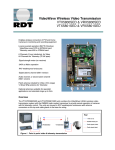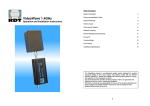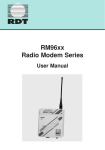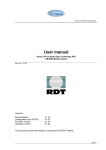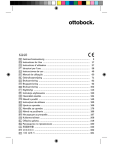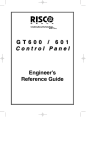Download RDT RM96xx Installation guide
Transcript
VideoWave 5.8GHz Operation and Installation Instructions Table of Contents System Description 3 Survey and Installation Guide 4 Antenna Mounting 8 Antenna Types 9 Transmission Distance 9 Wireless Telemetry 10 External Weatherproof Enclosures 11 Audio and Alarms 12 Technical Notes 13 Fault Finding 15 VideoWave Specifications 16 The VideoWave system is a professional quality system designed for sending composite NTSC or PAL video signals. All products comply with the R&TTE Directive 1999/5/EC. Models are available with various power outputs for license-free operation in most European countries. Due to the license-free operation of these products, there is no guarantee that interference will not occur in a particular installation. RDT does not assume any responsibility for the use of the products described. No product patents are implied and RDT reserves the right to change the said products without notice at any time. 2 System Description The VideoWave Wireless Video Transmission is a professional system designed for sending composite NTSC or PAL video signals using 5.8 GHz wireless technology. Figure 1 - Transmitter connections SMA Antenna Connector Cable Gland for Audio/Digital Channels BNC Connector for Video Input Cable Gland for DC Supply Figure 2 - Receiver connections SMA Antenna Connector Cable Gland for Audio/Digital Channels BNC Connector for Video Output Cable Gland for DC Supply 3 Survey and Installation Guide Before carrying out installation, it is important to bench test and familiarize yourself with the equipment. This manual will help with antenna choice, transmission performance, achievable distance etc. Note: The longer the radio path the more critical details of installation become. Bench Test The Videowave systems is supplied as standard with an ANT5805, Patch antenna. These will be sufficient for testing and for use over short to medium distances (see table on Page 9). Before testing the VideoWave equipment, connect the camera to be used, directly to the monitor with a 75 ohm cable and check for correct operation. Fit the antenna to the VTX unit (transmitter) and connect the 12V dc supply (or the mains supply in an SE version). The 7 segment LED will light indicating 'power on' and also indicating the current selected channel. Now connect the camera to the video input. Note: Do not power the unit without an antenna connected. Always disconnect power to the transmitter before connecting or removing the antenna. Failure to do so may damage the unit. Fit the antenna to the VRX unit (receiver) and connect the power. The 7 segment LED will light to show 'power on' and indicate channel. Make sure the channel is the same as the TX (if not, select the correct channel using the channel select push button beneath the 7 segment display). The signal strength meter should also light. If the two units are fairly close together for bench testing, all LEDs, 2 x red, 1 x orange and 3 x green, should light. Connect the video output to the monitor. The picture should appear on the monitor and be clear with no distortion. System Performance The VideoWave functions in exactly the same way as standard broadcast TV transmissions, but on a much lower signal strength. TV aerials are normally installed as high as possible to give the clearest signal path and achieve good reception. In most cases if the external TV aerial is disconnected and replaced with a small indoor aerial, the reception becomes poor. In the same way, VideoWave will always perform best by adopting the same principle. Terrain, antenna height and signal strength will always be the deciding factors in achieving good communications. In an ideal installation 'LINE-OF-SIGHT' between the transmitter and receiver will give optimum results (see Technical Notes). Obstacles blocking the line of sight will reduce transmission distances and affect picture quality. The video signal may pass through walls of brick or wood, with some degree of attenuation, but metal objects will almost certainly block the signal; the denser the obstacles the greater their effect. Note: Metal objects near or directly behind the antennas may also have an adverse effect. If possible carry out a survey to establish good communications before final installation. 4 Site Survey It is advisable to carry out a survey to establish a good radio path prior to installation. This will help with the positioning of the equipment and choice of antenna. Your distributor should be able to assist with information and may be able to provide a Survey Kit and antennas for this purpose. Before commencing a survey, measure or estimate from a map, the straight-line distance between the two sites. From the tables on page 9, check which type of antenna would be needed to cover the required distance. Visit the sites to see if there is a suitable location for equipment and the antennas, normally on the roof of the building. It should also be possible to see if there is a reasonable line-of-sight between the two locations or if there are any significant obstructions. (See Technical Notes). A pair of field glasses may be useful if the sites are some distance apart. Make a temporary installation of a camera and transmitter. Note: battery-operated equipment is available for this purpose. Position the antenna and leave the equipment running. At the receive site, set up the receiver and monitor. Position the antenna and adjust its position to get the best signal strength indication on the receiver unit (up to three GREEN LED's). If the picture quality is not good, or the signal strength is low, try moving the antenna to other locations. Performance will be affected by obstructions or metal objects nearby. Even the antenna mounting pole can cause a problem if the antenna is not correctly mounted clear of the pole. For longer distances, it may be necessary to use a high gain antenna on the receiver site. Note: High gain antennas are directional and must be aimed at the transmission site and then adjusted by rotating until maximum signal strength is achieved. The POLARISATION of both antennas must match. For example, if the transmitting antenna is vertical then the receiving antenna must also be vertical. If the signal strength is too low it may be increased by raising the height of the transmit antenna, receive antenna or both. Care must be taken, however, because there will be a loss of signal in the cable and connectors. For the actual installation, a good quality low-loss cable should be used between the antenna and the VideoWave units (i.e.LMR400). Alternatively, the VideoWave unit, which is housed in a weatherproof enclosure, can be mounted on the pole near the antenna to keep cable lengths to a minimum. If the picture quality is poor, even with reasonable signal strength, this may be due to interference. Remember that this is a license free band and other users could be transmitting in the area. If interference is suspected, try turning off the transmitter and checking the LED signal strength meter on the receiver. Only the first red LED should be on to indicate 'power on'. If the amber or any of the green LED's are on or flickering, this indicates the presence of another signal. Try moving the antennas, or changing to another channel. 5 Transmitter Camera Receiver Monitor 230V Mains Power 230V Mains Power Figure 3: The most common connection diagram for setting up a simple wireless video link using the VideoWave system. Installation For this section, it is assumed that the equipment has been bench tested, is working correctly and that a site survey has been completed. If not, carry out these tests before beginning the installation. Transmitter Start by installing the transmitter in the required location. The transmitter can either be located inside or outside. It is housed in a weatherproof IP67 enclosure. (See page 11) Generally, the higher the antenna can be mounted, the better the radio performance. There are therefore two choices; mount the transmitter high with the patch antenna connected directly to the top of the transmitter or remotely mount the antenna using a suitable cable. The recommended cable, LMR400, has a loss of about 0.3dB/mtr at 5.8GHz, and you should also allow about 0.2dB for each connector. Using these figures as a guide, the recommended maximum cable length is about 5 metres (about 2dB loss, including connectors). Longer cables may be used, in order to clear a building or obstruction, but in this case it may be necessary to use a higher gain antenna to compensate for the cable loss. (see table on page 9 for antennas and cables) Install the camera in the required position and connect to the transmitter using a 75 ohm coax cable. Connect the power to both units. Before leaving the transmitter site, if possible, check that the unit is working correctly using the receiver unit connected to a monitor. It may be necessary to adjust the camera view or lens iris to obtain the clearest picture. 6 Receiver Installation of the receiver unit is basically a repeat of the transmitter installation. The antenna selection will depend on the distance from the transmitter site and the results of the site survey. The standard patch supplied is suitable for distances of up to about 1Km maximum (depending on local conditions). Other antennas are available for distances up to about 3Km. (see table on page 9). Note: The higher gain antenna should be fitted to the receiver. When the antenna is in position, before finally tightening the fixings and securing the cable, connect the receiver unit and connect a monitor to the receiver. Check the signal strength at the receiver using the LED indicators. All three green LED’s indicate the strongest signal but one green LED should still give enough signal for a reasonable picture. Try adjusting the position and direction of the antenna to give maximum signal strength. Check the picture on the monitor. Again adjust the antenna position if required to obtain the best possible picture. Because of reflections and multi-path, small movements of the antenna can have a significant effect. If interference is suspected, try changing to another channel (this must be done on both the transmitter and the receiver). If a high gain antenna is being used, aim the antenna in the direction of the transmitter. Make sure that the polarization of the two antennas match. Using the signal strength indicator or the picture on the monitor, rotate the antenna in the horizontal plane until the best picture is achieved. Once the best results have been obtained fix all the equipment in position. Note: As with the transmitter installation, cable lengths should be kept to a minimum to reduce losses. Again, consider mounting the receiver unit close to the antenna. General It is important that antennas are mounted correctly and securely. Remember that on a high pole, although the antennas are relatively small, there will still be a considerable wind loading. If in any doubt, contact a qualified aerial rigger. It is essential that the polarization of the transmitting and receiving antenna is matched. Make sure that all connections are weatherproof. This can best be achieved by covering all connectors with a layer of self-amalgamating tape. Also make sure that cable entries to buildings are well sealed with mastic. 7 Antenna Mounting Figure a Figure b Figure c Figure d The above diagrams show some typical examples of antenna mounting. a. Not recommended. The mounting pole will have an effect on the antennas performance and could cause reflections. b. This is the preferred arrangement where the antenna is clear of the mounting pole. c. Not recommended. Although in this position the antenna may work, especially if the radio path is away from the wall, the proximity of the wall can cause adverse effects. Many walls, for example, have steel reinforcing or even metal cladding. d. This is the preferred arrangement with the antenna clear of the building. A small pole mounted on ‘A’ brackets may be required to clear the roof overhang, as shown. Antenna Types and Performance Any of the following antennas may be used in combination to give the best possible link quality. Always make sure that the polarity is matched i.e. both vertically polarized. High gain antenna, such as the 20dB Panel, should only be used on the receiver. A small amount of gain is acceptable on the transmitter to compensate for cable losses providing the ERP (maximum output power at the antenna) does not exceed the limit. 8 7.5cm 50cm 10cm ANT5803 – Omnidirectional whip antenna. ANT5805 – 5dB gain patch antenna (supplied as standard). ANT5808 – 8dB gain omni-directional dipole antenna, ANT5810 – 10dB gain panel antenna ANT5820 – 20dB gain panel antenna ANT5828 – 28dB gain parabolic dish antenna Transmission Distances (Line-of-Sight) Antenna Description Distance ANT5803 ANT5805 ANT5808 ANT5810 ANT5820 ANT5828 500mtrs 1Km 1Km 1.4Km 3Km 4Km ½ Wave Whip Omni-directional 5dB gain Patch 8dB gain Dipole Omni-directional 10dB gain Panel 20dB gain Panel 28dB gain Parabolic Dish 9 Wireless Telemetry Telemetry for controlling PTZ cameras etc. cannot be transmitted directly over the VideoWave but requires the addition of a Radio Modem to transmit the data. The RM96XX series of modems is designed for use in the license free bands and is approved for all European countries. The modem is compatible with most commercially available video telemetry units. Installation The RM96XX modem can be supplied separately or mounted alongside the VideoWave unit in an IP67 enclosure. (SED versions) Because the modem relies on a good radio path, the installation procedure and test methods should be basically the same as for VideoWave. It is always best to carry out a survey to ensure good signal strength. The 96XX modem will normally operate over a much greater distance than the VideoWave system, therefore if a suitable site is found for the VideoWave, there should be no problem with the modem link. Care must be taken in selecting the correct antenna and the antenna installation. Follow the same principals as for VideoWave. If using remote antennas for higher gain or increased height, it is recommended to mount the video and telemetry antennas a minimum of 3 metres apart, where possible. See the RM 96XX User Manual, supplied with the unit, for details on modem operation and set-up. Application notes are available giving details of the modem settings for most of the common telemetry systems. RS485/ Baud Data Stop RS232 Rate Bits Bits Parity Telemetry Manufacture/Protocol American Dynamics (sensormatic) RS485 4800 8 1 None Baxall Baxnet RS485 9600 8 1 None BBV RS485 RS485 9600 8 1 None BBV 20mA RS232 1200 8 1 Even Conway RS485 9600 8 1 None None Dennard dome RS485 9600 8 1 Dedicated Micros DS2 remote keyboard RS232 19200 8 1 None Honeywell Orbiter RS485 9600 8 1 None Honeywell KD6 RS485 9600 8 1 Even Honeywell HRHD remote keyboard RS485 9600 8 1 None Mark Mercer RS485 9600 8 1 None Bewator/Molynx Panasonic RS485 RS485 9600 4800, 9600 8 8 1 1 Even None Pelco D Pelco P RS485 RS485 2400 4800 8 8 1 1 None None Pelco P (9600) RS485 9600 8 1 None Vicon RS485 4800, 9600 8 1 None Videoswitch Vi series DVR RS485 9600 8 1 None Vista DVR remote keyboard (Baxnet) RS485 9600 8 1 None 10 Vista Powerdome IP67 Weatherproof Enclosures RS485 9600 8 1 None Enclosure for VideoWave Transmitter or Receiver Model VTX/VRX5800S Enclosure for VideoWave Transmitter or Receiver Model VTX/VRX5800SE The enclosure has a SMA antenna connector on the top and a BNC for video on the bottom. Cable glands are provided on the bottom for 12Vdc and alarm /audio cables. (These options are available on the 5801 versions) The enclosure has a SMA antenna connector on the top and a BNC for video on the bottom. Cable glands are provided on the bottom for mains and alarm/audio cables. (These options are available on the 5801 versions) Enclosure for VideoWave Transmitter or Receiver and Radio Modem Model VTX5800SED or VRX5800SED The enclosure is supplied with top antenna connectors There is a SMA connector for the Video antenna and a BNC for the data. The bulkhead also has cable glands to seal the video, data and power input leads. There is a further gland for the alarm and audio connections. (These options are available on the 5801 versions) 11 Audio and Alarms (5801 Versions) 1) BNC connector on the base for video input (transmitter) and video output (receiver). 2) SMA antenna connector. 3) Cable gland for DC supply 4) Cable gland for audio and digital channels. 5) DC terminal block 6) Channel number, 7 segment display 7) Channel change push button 8) Signal strength meter (receiver only) 9) Audio and digital terminal block (5801 version only) 10) Link to select digital or audio for second channel (5801 version only) The units require a supply of 12V dc nominal (actual input range is 9 to 28V) at a current of 75mA for the transmitter and 215mA for the receiver. Video input from the camera is connected to the BNC connector on the base of the transmitter unit. Video output to the monitor, DVR etc. is from the BNC connector on the bottom of the receiver. There is a SMA antenna connector on the top of each unit On the 5801 versions there is also the option of audio and digital alarm channels. These connections should be wired through the second cable gland and connected to the terminal block as indicated on the PCB. The inputs for the digital alarm channels on the transmitter are volt free contacts. On the receiver there are corresponding changeover relay outputs with contact rating 1A @ 30V dc The audio input on the transmitter is 1 V p-p into 100KΩ unbalanced. The receiver output is 1 V p-p (for a 1 V p-p input) with a frequency response of 50Hz to 15KHz. Note that the audio channel can be linked out and used as a second digital alarm channel. This is link selectable as shown in the above diagram, position 10. 12 Technical Notes Propagation/Distance For any radio link, the distance that can be achieved between sites depends on a number of factors, the main ones being; the output power, the antenna height (above ground), the type of terrain and ‘line-of-sight’. Line-of-sight means how clear the path is between the two antennas, whether there are any obstructions and how dense these obstructions are. The major effect on distance however, is the height of the antennas above ground. The basic relationship between signal strength, antenna height and distance is given in the following formula:Signal strength : (TX antenna height)² x (RX antenna height)² (Distance)4 From this formula it can be seen that if the distance doubles, the signal strength decreases to one sixteenth. In other words, to increase the distance from 1 Km to 2 Km, requires an increase in signal strength of sixteen times. It can be seen therefore that increasing output power has a limited effect on distance. Increasing the antenna height however, has more effect. If the antenna height (above ground) is doubled, the effective signal strength increases four times. This is true for either the transmitting or receiving antenna so by increasing the height of both a significantly greater distance can be achieved. Clear line-of-sight When we refer to a clear line-of-sight for radio signals, this is different to a visual lineof-sight. You may be able to see the transmitting antenna from the receiver site, but this does not necessarily mean a good radio path. A radio signal transmitted between two antennas will spread out forming an elliptical shape that is widest at the mid distance between the two antennas. The area within this ellipse is known as the Fresnel Zone and any obstructions within this zone will cause an obstruction and interference to the signal path. TX Fresnel Zone Radius RX Note that this Fresnel Zone is three dimensional and has both height and width. The maximum radius of the beam, at the centre, increases with the distance between the two antennas. As a guide, at 2.4GHz the radius for a particular signal path is: 1Km signal path 4 - 5Mtr radius 2Km signal path 5 - 6Mtr radius 5Km signal path 8 - 9Mtr radius This means for example, that if the link is 2Km long, the antennas must be at least 5 to 6 metres above the ground and above any building or obstruction. There must also be the same 5 to 6 metres clearance to either side. It should also be remembered that radio signals at 5.8GHz will not normally pass through buildings and they will be severely attenuated by vegetation, such as trees. 13 Reflections The best possible performance and therefore distance, will be achieved if there is perfect unobstructed line-of-sight between the two sites ‘A’ and ‘B’. Even in this situation however there is almost certain to be some degree of reflections from the ground or nearby structures. These reflections will have an effect on the signal strength and the final picture quality obtained. It is useful therefore to understand the basic principals of a radio link and the effect of reflections. The most common reflection is from the ground although other structures, buildings etc. will have a similar effect. The reflections from these other structures are less predictable because they depend on the shape of the structure, construction material etc. Consider a radio path between site ‘A’ and ‘B’ with each antenna 10 metres from the ground. Assuming good line of sight, there will obviously be a path directly between the two antennas, drawn as a straight line on the diagram. There may also be one or more paths that are reflected from the ground and reach site ‘B’ indirectly via a point on the ground, ‘X’. Obviously the distance A-X-B is longer than the direct route A-B. The receiver at site B will receive a direct signal and a reflected signal via point X. The effect of this reflected signal depends on its strength and the difference in length between A-B and A-X-B. If the difference is a multiple of the wavelength (approximately 12.5cm for 2400) the reflection is 180º out of phase and will reduce the received signal strength. In fact if both signals were the same strength they would cancel and no signal would be received. Because at these frequencies the wavelength is quite short, even a small adjustment in antenna height can affect the path length of the reflected signal and so change the received signal strength. By raising the antenna gradually it will cycle through a regular pattern of in phase and out of phase signals giving a corresponding pattern of reduced and increased signal strength. 14 Interference Because the 5.8 GHz frequency band is an unlicensed public access bands, there is no control on other users. It is therefore possible that another user could be operating on the same frequency in your area. If this is suspected, turn off the transmitter and see if there is any activity on the LED’s of the receiver. If there is a transmission on the same frequency the amber or green LED’s should light or flash indicating the received signal. If there are other users it may be possible to avoid interference by changing channels or by repositioning the antenna. A directional antenna may also reduce the effect. The reflected signal will show up as ghosting on the monitor. Occasionally this may be seen in adverse weather conditions when a signal may be reflected from rain, snow, dense cloud or fog. Fault Finding No LED's illuminated Venetian blind effect Low or no signal strength Snowy or grainy picture Picture rolling or tearing Possible solution Check power supply. TX – 7 segment channel indicator should be on. RX – 7 segment channel indicator should be on, plus the first red LED of the signal strength meter Incorrect voltage from power supply. Should be 12V on –S versions Check video input on transmitter. See pages 5 and 13 regarding antenna height and position. Weak signal. Check number of GREEN LED's on VRX units signal strength meter. See pages 5 and 13 regarding antenna height and position. Reflections. See page 13 Check output voltage from camera. Should be 1V p-p 15 Specification General Video Input 1V p-p into 750ohm BNC Video Output 1V p-p into 750ohm BNC Operating Voltage 240V AC Protection Reverse Polarity Power Consumption @ 240V AC Transmitter 1W Receiver 2.6W Antenna Connector 50ohm SMA (Female) Power Connector Screw terminal Indicators Channel / ON 7 segment display Signal Strength (RX) LED bar graph Radio Modem Frequency Range Channel Spacing No. of Channels Transmitter RF Power Output Adj. Channel Power Freq. Tolerance FM Deviation Receiver RF Sensitivity Intermodulation 406-470MHz* 25KHz 32 50-500mW (4 steps) -37dBm +/- 1KHz +/- 3.5KHz -110dBm for 10BER -70dB Radio Frequency range RF Power Output Local Oscillator Modulation Type Modulation Bandwidth Adj. Channel Rejection RSSI Threshold Level Max Bit Rate Modulation Interface Baud Rate Parity Power Consumption at 240V Transmitter at 500mW Receiver 5725 – 5875MHz 25mW ERP PLL Synthesised FM 4.5MHz -70dB -105dBm 16k -110dBm at 8k 16kbps GMSK 150-19.2 Kbaud Odd, Even, None 7.2W 4.2W * UK Specification is 15 channels 458.525 to 458.925MHz Mechanical Dimensions Height* Width Length 255mm 180mm 80mm Weight Enclosure Mounting 1.8kg Polycarbonate IP67 4x7mm diameter holes Spacing 238.5x163.5 Operating Temperature -10 to +55°C *Excluding connectors and cable glands. Equipment conforms to the R&TTE Directive 1999/5/EC Radio Data Technology Ltd 10-11 Taber Place Crittall Road Witham Essex CM8 3YP England Telephone: 0044 (0) 1376 501255 Telefax: 0044 (0) 1376 501312 Email: [email protected] URL: www.radiodata.co.uk A member of the CML Microsystems Plc group 16
















